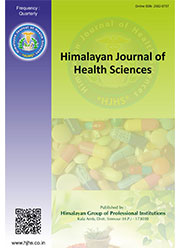Modern and Classical Aspects on Infectious Diseases and their Management w.s.r. to Current Pandemic Situation: A Review
Abstract
The ancient term Sankramaka Roga resembles communicable diseases as per modern science. These diseases mainly arise due to the influence of microbial invasion inside the body. The transmissions of such disease from one person to another take places via various means including Gatra Sansparsha, Prasnaga, sleeping and eating together; sharing objects and sexual contact, etc. The microbial toxin induces pathogenesis of infectious diseases after invasion of microorganism inside the body. Sankramaka Roga turned to Janapadodhwamsa if large numbers of people get affected, this condition can be correlated with resembles situation as per modern science. The modern science described uses of antibiotics and immune-therapy for the management of these diseases. Similarly Ayurveda rely on natural drugs, classical formulations, Panchakarma and Rasayana Chikitsa, etc. to treat Sankramaka Roga. Ayurveda concept of Ahara-Vihara, Dinacharya, Ratricharya, Ritucharya and Sadvritta improves immune system thus helps to prevent pathogenesis of Sankramaka Roga. Present article explores modern and classical aspects on infectious diseases and their management w.s.r. to current pandemic situation.
References
2. P.V. Sharma, Susruta Samhita, reprint 2005, Varanasi, Chaukhambha Visvabharati; 2005.p.44
3. Kaviraj Atrideva Gupta, Astang Hrdayam. reprint 2009. Varanasi: Chaukhambha Prakashan. 135p. 8. Harish Chandra Singh Kushwaha, Carak Samhita – second part, Reprint 2012,Varanasi,Chaukhamba Orientalia. 1p.
4. Agnivesha, Charaka Samhita elaborated by Charaka & Drudhabala with Ayurveda-Deepika Commentary by Chakrarapanidatta, edited by Dr. Brahmanand Tripathi. Varanasi: Choukhambha Surbharati Prakashan. Reprinted 2011. Sutra sthana chapter 19, verse no.5, page no. 111.
5. Atal CK, Sharma ML, Kaul A, Khajuria A. Immunomodulating agents of plant origin. I: preliminary screening. J Ethnopharmacol. 1986; 18:133-41.
6. Patwardhan B, Payyappalli U. Ayurveda and antimicrobial resistance. J Ayurveda Integr Med. 2018; 9(2): 85-86.
7. Rege NN, Nazareth HM, Bapat RD, Dahanukar SA. Modulation of immunosupression in obstructive jaundice by Tinospora cordifolia. Indian J Med Res. 1989;90:478-83.
8. World Health Organisation. Q&A on coronaviruses (COVID-19 [Internet]. WHO; 2020 Oct 30 [cited 2021 Jul 02]. Available from: who.int
9. Yuki K, Fujiogi M, Koutsogiannaki S. COVID-19 pathophysiology: a review. Clin Immunol. 2020; 215:108427.
10. RastogiS. Deep Narayan Pandey, ram Harsh Singh. COVID 19 Pandemic: A pragmatic plan for ayurveda intervention. Journal of Ayurveda and Integrative medicine. 2020;10: 02.
11. Professor K. R. Shrikantha Murthy, translated in English, Ashtangasangraha. Part-III. Varanasi: Chowkhaba Orientalia; 2005. p.12.

This work is licensed under a Creative Commons Attribution-NonCommercial 4.0 International License.
The International Journal of Innovative Science & Technology affairs require a formal written transfer of copyright from the author(s) for each article published. We therefore ask you to complete and return this form, retaining a copy for your records. Your cooperation is essential and appreciated. Any delay will result in a delay in publication.
I/we have read and agree with the terms and conditions stated Page 2 of this agreement and I/we hereby confirm the transfer of all copyrights in and relating to the above-named manuscript, in all forms and media, now or hereafter known, to the International Journal of Drug Regulatory affairs, effective from the date stated below. I/we acknowledge that the IJDRA is relying on this agreement in publishing the above-named manuscript. However, this agreement will be null and void if the manuscript is not published in the IJIST.
Download link for COPYRIGHT FORM





